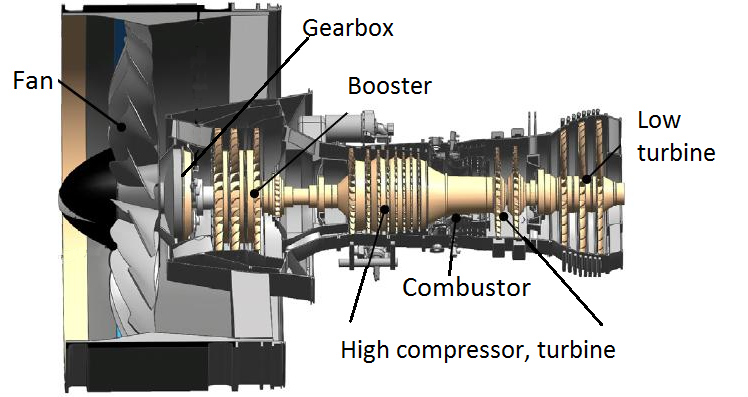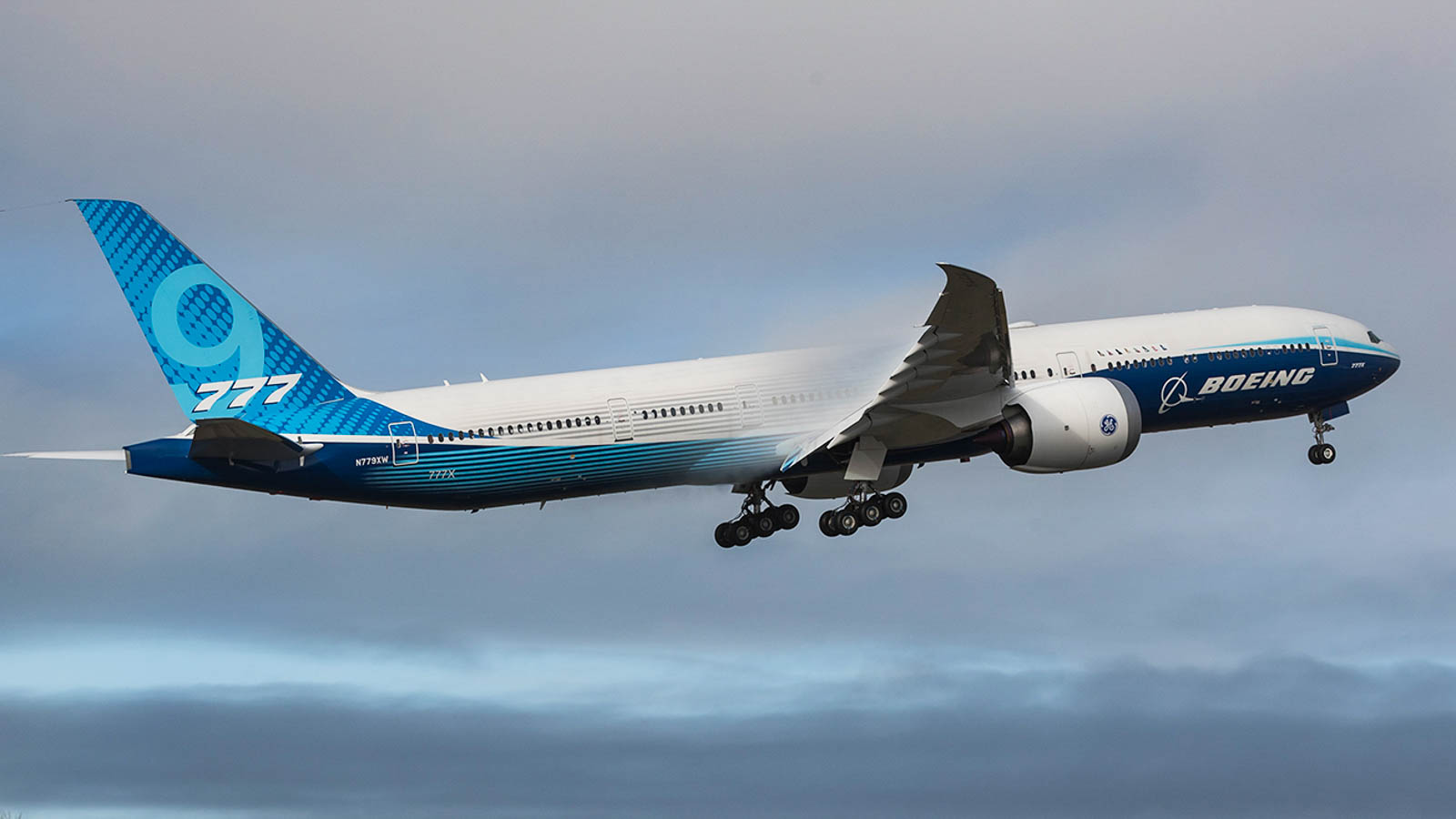Leeham News and Analysis
There's more to real news than a news release.
 Leeham News and Analysis
Leeham News and Analysis
- Bjorn’s Corner: New engine development. Part 4. Propulsive efficiency April 19, 2024
- Boeing unlikely to meet FAA’s 90-day deadline for new safety program April 18, 2024
- Focus on quality not slowing innovation, says GKN April 18, 2024
- Boeing defends 787, 777 against whistleblower charges April 17, 2024
- Dissecting Boeing CEO’s statement next new airplane will cost $50bn April 15, 2024
Pontifications: Moonshot for engines for Next Boeing Airplane may have to wait
Sept. 12, 2023, © Leeham News: The Next Boeing Airplane (NBA) may be a moonshot for CEO David Calhoun, but airlines will probably be reluctant to take a moonshot on the next new engine.
Service issues with the CFM LEAP and Pratt & Whitney GTF engines are driving airlines batty. The failures of the Rolls-Royce Trent 1000 years after entry-into-service (EIS) cost RR hundreds and millions of dollars and a confidence crisis that hurt future sales. LEAP engines are coming off wing well before initial forecasts. Every aircraft model using the GTF faced groundings as engine failures piled up.
Boeing sorely needs a successor to the 737, now in its 55th year and fourth iteration. Ron Epstein, the aerospace analyst for Bank of America, was biting in a Sept. 7 research note.
Flying a Boeing 737 is like driving a ‘68 Chevy Impala with a semi-modern dash.
“We note that Boeing continues to ride on the coattails of its past glory. The original Boeing 737 prototype first flew in April 1967, entering service less than a year later in February 1968 with Lufthansa. Fifty-five years later, the 737 airframe remains in service through a multitude of derivative models, including the most recent 737 MAX,” he wrote.
“However, we note that the model was never intended to be such a blockbuster long-term solution. Instead, the 737 was expected to be a band-aid for the Boeing portfolio to compete with the market share-winning DC-9. The Boeing fleet lacked a smaller narrowbody model to complement the company’s larger jets, like the 707. In the spirit of the General Motors model, the 737 was intended to be the ‘cheap Chevy’ of the portfolio. Fledgling carriers would operate the cheaper model before upgrading to Boeing’s large, higher-end products like the 707 and, later, the 747, which one could see as the ‘Cadillacs’ of the portfolio.
“In our view, while the longevity of the 737 is impressive, the aircraft is now a bit of an anachronism. Operating the aircraft is like driving around in a 1968 Chevy Impala with a semi-modern dashboard. It is important to note that the 737 is the only currently manufactured commercial aircraft without fly-by-wire controls, which are a staple in modern aircraft control system design.”
Epstein worked for Boeing from 1995 to 1999 as an Applied Research Scientist. He’s a technical advisor to United Airlines for the alternative energy sector.
Posted on September 12, 2023 by Scott Hamilton
United selects GEnx for order for 100 787s
Subscription Required
By Scott Hamilton
Aug. 14, 2023, © Leeham News: United Airlines quietly selected GE engines for its order in December last year for 100 Boeing 787-9s, according to Boeing’s website. The order isn’t finalized and neither GE nor United would comment.
There had been speculation that UAL might order Rolls-Royce engines as a mitigation for cancelling 45 Airbus A350-900s, which is powered exclusively by RR. United repeatedly deferred delivery of the A350s, which were ordered by previous managements. United inherited a large order for 787s when it merged with Continental Airlines and placed repeat orders for the 787 after the merger. The A350s essentially are duplicative to the 787s.
United placed large orders for the Airbus A321neo at a time when Boeing at first dithered whether to launch the New Midmarket Aircraft. UAL added to the neo order during the time when Boeing was unable to pursue any new airplane program due to the extended grounding of the MAX and during the COVID pandemic.
Posted on August 14, 2023 by Scott Hamilton
Pontifications: Engine makers’ business model needs overhaul
May 2, 2023, © Leeham News: The business models for engine makers for decades have been simple: deeply, deeply discount the engines on the sale and make up the revenue and profits on the maintenance, overhaul, and repair (MRO) contracts.
It’s a model that’s served engine makers and customers alike well. Customers save millions of dollars on the upfront purchase of airplanes. The engine companies win market share.
There are downsides for the Original Equipment Manufacturers (OEMs), though. The discounts typically are steeper than those offered by Airbus and Boeing (and Embraer and ATR). LNA has seen deals with discounts as steep as 80% on the sales price. We’ve even seen one deal in which the OEM gave (as in free) the engines in exchange for the MRO contract.
The big downside to this is that it can take 10-12 years, or more, for the OEMs to recover their research and development and production ramp/learning curve costs. Then as the CFM 56 matured into perhaps the most reliable jet engine ever, with more than 25,000 hours on-wing, followed by the IAE V2500, MRO services contracts didn’t return the revenue and profits as quickly as before.
Posted on May 2, 2023 by Scott Hamilton
Bjorn’s Corner: New aircraft technologies. Part 10P. The engine choice
Subscription required
By Bjorn Fehrm
April 28, 2023, ©. Leeham News: This is a complementary article to Part 10. The engine choice. It discusses in detail the next-generation engines for the Heart of the Market airliners that today are called the single-aisle segment. What will be the alternatives and final engine choice? Will hydrogen-fueled engines play a role?
Posted on April 28, 2023 by Bjorn Fehrm
Bjorn’s Corner: New aircraft technologies. Part 9. Engine core advances
April 21, 2023, ©. Leeham News: This is a summary of the article New aircraft technologies. Part 9P. Engine core advances. The article discusses how developments for the next-generation airliner engine cores will increase the thermal efficiency of next-generation engines.
Posted on April 21, 2023 by Bjorn Fehrm
Bjorn’s Corner: New aircraft technologies. Part 9P. Engine core advances
Subscription required
By Bjorn Fehrm
April 21, 2023, ©. Leeham News: This is a complementary article to Part 9. Engine core advances. It discusses in detail the next-generation propulsion system cores and what efficiency improvements to expect from different technological advancements.
Posted on April 21, 2023 by Bjorn Fehrm
Pontifications: One “good” engine in future for RR, faulty business strategy and model: JP Morgan
Feb. 7, 2023, © Leeham News: Our report last week about Rolls-Royce’s new CEO characterizing the company in dire straits is just part of the story. Shortly before that, on January 18, JP Morgan issued a 38-page dissection of the company that perfectly encapsulates what LNA has pointed out in the past about its commercial engine business.
Posted on February 7, 2023 by Scott Hamilton
Pontifications: New Rolls-Royce CEO paints a dire picture; all scenarios on table at Airbus
Jan. 31, 2023, © Leeham News: Rolls-Royce’s new CEO says the engine group is a “burning platform,” failing to give returns.
Tufan Erginbilgic, who joined RR as CEO on Jan. 1, said this is the “last chance” to get its house in order and turn a profit.
The dire outlook has potentially disastrous implications for Airbus. The airframer relies exclusively on Rolls for its engines for the A350 and A330neo. Airbus is monitoring the situation closely. Market sources tell LNA that Airbus is assuring customers and potential customers that Airbus will make sure engines and aftermarket support are available, without detailing how.
An Airbus insider tells LNA that all scenarios are under consideration. Some speculate that Airbus might either provide financial support to Rolls or even, in the extreme, buy the engine company. Others believe either course is unlikely because Airbus has its own production problems to sort out. Its fiduciary duty is to its stockholders. “It’s not their job to inherit a problem that was created decades ago,” one London-based analyst says.
What’s at the root of RR’s current problems? Many of the reasons have been discussed before, but let’s summarize them.
Posted on January 31, 2023 by Scott Hamilton
Pontifications: A lost decade for new airplanes
Subscription Required
Dec. 5, 2022, © Leeham News: In September 2020, LNA wrote that commercial aviation was facing a “lost decade.”
The impetus for this prediction was the COVID-19 pandemic crisis.
“Commercial aviation is facing a lost decade due to COVID,” we wrote. “Yes, most forecasts target 2024-2025 as returning to 2019 passenger traffic and aircraft production levels. However, LNA in July published its own analysis indicating full recovery may not occur until 2028.”
Nobody predicted that effective vaccines would emerge as quickly as they did. Drug makers in the US and Europe moved heaven and earth to produce vaccines to fight COVID-19. These have been, by and large, extremely effective. (I’ve had two shots and three boosters and have not caught COVID, despite being at one major conference with 13,000 people.)
China created its own vaccine, which failed to stem the tide there. President Xi quickly adopted total lockdowns at the first sign of outbreaks. Despite this, China is now setting records for new infections. Commercial aviation recovery there remains underperforming. China’s performance illustrates the underlying reasoning we had in concluding commercial aviation was facing a lost decade.
This sector still faces a lost decade, though for some fundamentally different reasons.
Posted on December 5, 2022 by Scott Hamilton
Engine Development. Part 10. Next generation engines
Subscription Required
By Bjorn Fehrm
Introduction
October 20, 2022, © Leeham News: We finish our series about engine development by looking at the next-generation engines and future trends in airliner engine development.
We limit this look forward to engines that burn Jet fuel (Jet-A1 or SAF) as green propulsion solutions are a vast field and justify their own series. We will pick this up at a future date.
Summary
- The major reduction in fuel consumption and, thus, CO2 emissions will come from new engines.
- The technologies to drive fuel consumption down a further 15% are there.
Posted on October 20, 2022 by Bjorn Fehrm
Email Subscription
Twitter Updates
My TweetsAssociations
Aviation News-Commercial
Commentaries
Companies-Defense
Resources
YouTube
Archives
- April 2024
- March 2024
- February 2024
- January 2024
- December 2023
- November 2023
- October 2023
- September 2023
- August 2023
- July 2023
- June 2023
- May 2023
- April 2023
- March 2023
- February 2023
- January 2023
- December 2022
- November 2022
- October 2022
- September 2022
- August 2022
- July 2022
- June 2022
- May 2022
- April 2022
- March 2022
- February 2022
- January 2022
- December 2021
- November 2021
- October 2021
- September 2021
- August 2021
- July 2021
- June 2021
- May 2021
- April 2021
- March 2021
- February 2021
- January 2021
- December 2020
- November 2020
- October 2020
- September 2020
- August 2020
- July 2020
- June 2020
- May 2020
- April 2020
- March 2020
- February 2020
- January 2020
- December 2019
- November 2019
- October 2019
- September 2019
- August 2019
- July 2019
- June 2019
- May 2019
- April 2019
- March 2019
- February 2019
- January 2019
- December 2018
- November 2018
- October 2018
- September 2018
- August 2018
- July 2018
- June 2018
- May 2018
- April 2018
- March 2018
- February 2018
- January 2018
- December 2017
- November 2017
- October 2017
- September 2017
- August 2017
- July 2017
- June 2017
- May 2017
- April 2017
- March 2017
- February 2017
- January 2017
- December 2016
- November 2016
- October 2016
- September 2016
- August 2016
- July 2016
- June 2016
- May 2016
- April 2016
- March 2016
- February 2016
- January 2016
- December 2015
- November 2015
- October 2015
- September 2015
- August 2015
- July 2015
- June 2015
- May 2015
- April 2015
- March 2015
- February 2015
- January 2015
- December 2014
- November 2014
- October 2014
- September 2014
- August 2014
- July 2014
- June 2014
- May 2014
- April 2014
- March 2014
- February 2014
- January 2014
- December 2013
- November 2013
- October 2013
- September 2013
- August 2013
- July 2013
- June 2013
- May 2013
- April 2013
- March 2013
- February 2013
- January 2013
- December 2012
- November 2012
- October 2012
- September 2012
- August 2012
- July 2012
- June 2012
- May 2012
- April 2012
- March 2012
- February 2012
- January 2012
- December 2011
- November 2011
- October 2011
- September 2011
- August 2011
- July 2011
- June 2011
- May 2011
- April 2011
- March 2011
- February 2011
- January 2011
- December 2010
- November 2010
- October 2010
- September 2010
- August 2010
- July 2010
- June 2010
- May 2010
- April 2010
- March 2010
- February 2010
- January 2010
- December 2009
- November 2009
- October 2009
- September 2009
- August 2009
- July 2009
- June 2009
- May 2009
- April 2009
- March 2009
- February 2009
- January 2009
- December 2008
- November 2008
- October 2008
- September 2008
- August 2008
- July 2008
- June 2008
- May 2008
- April 2008
- March 2008
- February 2008






